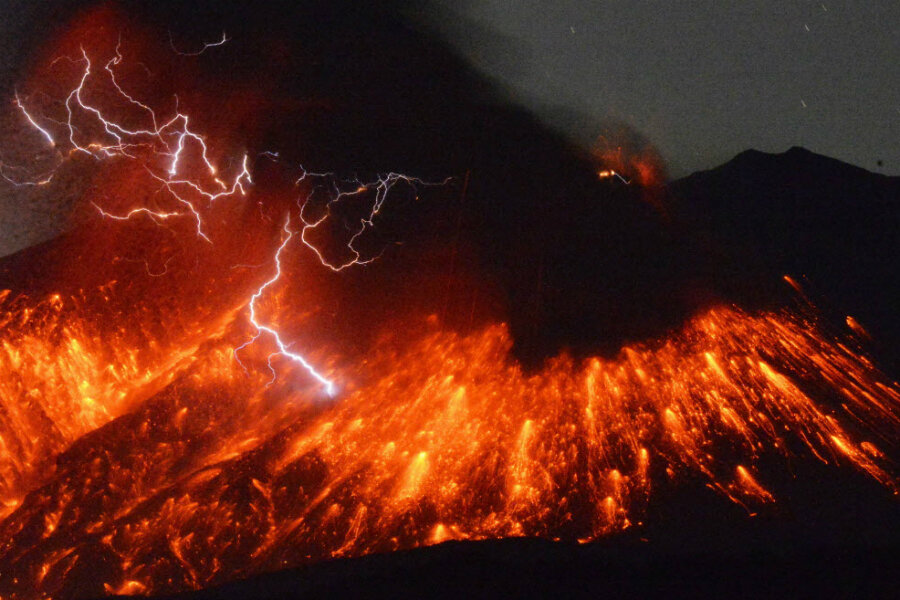Sakurajima's big burst: Are we getting better at forecasting eruptions?
Loading...
Sakurajima is getting ready to blow. This one won’t be just another daily belch: we’re talking hundreds of tons of sizzling rock, ash and lava.
But on the plus side, nearby communities have almost 30 years to prepare.
The Sakurajima volcano, which sits on the edge of Japan's Kyushu island, is known for its small, daily eruptions. But it’s due for a major discharge sometime around 2044, researchers say. In a study published Tuesday in the journal Scientific Reports, a team of volcanologists described a new model for forecasting Sakurajima’s behavior – a model that could lead to better natural disaster preparation worldwide.
This wasn’t the first attempt at predicting Sakurajima’s outbursts. A previous model, developed in the 1950s, was a simple pen-and-paper calculation. It operated under the assumption that the volcano’s internal magma pool was spherical, and that the surface above was flat. But the model couldn’t dependably account for the volcano’s activity.
“Our model relaxed these assumptions and allowed us to build a better picture of the volcanic system that was more consistent with the real world,” James Hickey, the lead author and volcanologist at the University of Exeter, told The Christian Science Monitor in an email.
This new model, Dr. Hickey says, accounts for the unusual topography of the area immediately surrounding the volcano, as well as the different properties of each layer of the Earth’s crust. As a result, it can more accurately forecast Sakurajima’s somewhat erratic behavior.
And that’s a good thing, because this volcano can do serious damage.
The last major Sakurajima eruption occurred in 1914. The burst produced intense pyroclastic flow and caused considerable flooding in the nearby city of Kagoshima. Lava flow, which is unusual for Japanese volcanoes because of their high silica content, was sustained for months. The explosion killed 58 people.
Using a seismometer and GPS data, the team found that the magma reservoir within Sakurajima was growing at a considerable rate. Taking that growth into consideration, they estimated that the next major eruption would occur about 130 years after the previous one. That means Sakurajima is due to blow in about 25 to 30 years.
Though limited in some respects – it’s based on just ten years of data, and there’s always uncertainty when it comes to natural disasters – the new model is “a step forward for volcano forecasting,” which is itself an imprecise science, Hickey says.
“We don’t use the word ‘prediction’ in volcanology,” Hickey says. “We use the term ‘forecast,’ as it includes a certain level of uncertainty.”
But in the history of natural disasters, to forecast is a considerable achievement.
When Mount Vesuvius erupted in AD 79, Pliny the Younger was there to record it. The Roman scholar, who was just 17 years old at the time, described the colossal columns of ash and pumice that blanketed Pompeii. It was the first comprehensive account of a volcanic eruption – similar bursts are now called Plinian eruptions.
In the days leading up to Vesuvius, Pliny noted frequent “earth tremors” that shook the Campania region of Italy. These tremors didn’t particularly alarm the patrician, as they were common in the area. The Romans hadn’t yet found the connection between seismic activity and volcanic eruptions.
Some Greco-Roman myths held that eruptions were the work of giants. Having been defeated by Zeus and buried beneath the earth, the monster Typhon was believed to have caused fiery explosions as he attempted to free himself.
Put another way, our understanding of these catastrophic events has come a long way. When Alaska’s Pavlof volcano erupted this year, scientists were able to sound a warning 25 minutes in advance. With new computer models and better seismograph technology, California researchers may have got a two-year jump on a severe earthquake that could hit Los Angeles.
And in July, scientists forecast the eruption of another massive, Roman volcano – this time, 1,000 years in advance.








